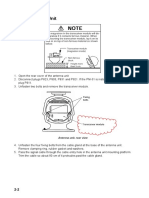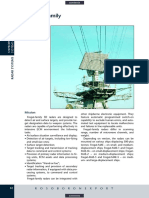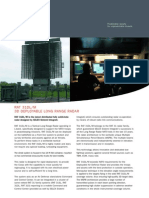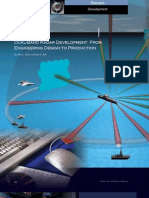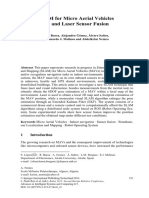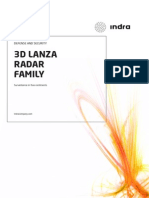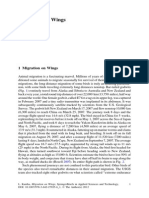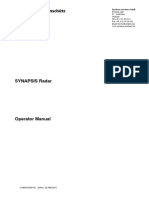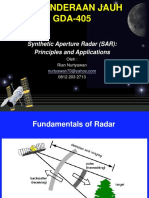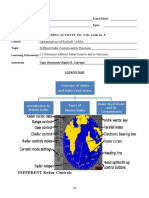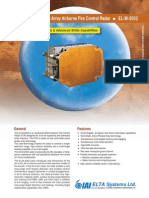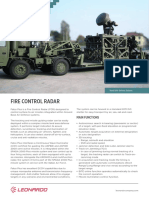50
50
Uploaded by
Pedro IvanCopyright:
Available Formats
50
50
Uploaded by
Pedro IvanOriginal Description:
Original Title
Copyright
Available Formats
Share this document
Did you find this document useful?
Is this content inappropriate?
Copyright:
Available Formats
50
50
Uploaded by
Pedro IvanCopyright:
Available Formats
ASTOR Sentinel R-1 (2005)
SENTINEL (originally ASTOR Airborne Stand-off Radar) is a British SAR/
GMTI platform that utilises the Dual Mode Radar, a derivative of the
Raytheon ASARS-2, on board a converted Bombardier Global Express
aircraft. It flew its first operational sortie over Afghanistan in February
2009. With its crew of 5, including 2 trained Image Analysts, it can provide
near-real-time, long-range, all weather, day-night battlefield intelligence
to ground commanders for wide area surveillance, reconnaissance, targetimaging and tracking.
50
Reconnaissance &
Surveillance
THALES I-Master radar (Courtesy of Thales UK.)
50.1 Manned Systems
Joint STARS is a long-range, long-endurance, air-to-ground
surveillance and battle management system carried aboard the
US Air Force E-8C aircraft. Operating at altitudes up to 12.8 km,
the systems high-power pulse Doppler radar is capable of
looking deep behind hostile borders from a stand-off position
and monitoring fixed and moving targets with a combination
of high-resolution SAR mapping and moving-target indication
(MTI) vehicle detection and tracking.
The radar employs an 8 m long, roll-stabilized, slottedwaveguide, side-looking passive ESA, housed in a radome
nearly 9 m long carried under the forward section of the fuselage (Figure 50-1). The antenna is steered electronically in azimuth and mechanically in elevation. In fact the antenna can be
rolled all the way from one side to the other allowing illumination to the right or left of the aircrafts flight path.
Multiple signal processors perform the digital processing. The
radar data and signal processors are controlled by an onboard
distributed processing system that includes individual digital
processors at each of 17 operator workstations and one navigator/operator workstation. All are readily accommodated in the
E-8Cs 43 m long cabin (Figures 50-2 and 50-3).
To separate targets having very low radial speeds from the accompanying mainlobe clutter, the displaced phase center technique
described in Chap. 26 is used. To enable the targets angular
positions to be precisely determined, the antenna is subdivided
lengthwise into three segments, also as described in Chap. 26.
The Joint STARS radar has three primary modes of operation:
Figure 50-1. Joint STARS. The three-segment passive ESA,
electronically steered in azimuth and manually steered in elevation,
is housed in the 9 m long radome under the forward section of the
fuselage. (Courtesy of US Air Force.)
High-resolution SAR imaging mode, for detecting and identifying stationary targets
703
704
PART X: Representative Radar Systems
Wide-area MTI surveillance mode, for situational awareness
Sector MTI search mode, for battlefield reconnaissance.
As the name implies, the MTI modes are used to locate, identify, and track moving targets. When a vehicle that is being
tracked stops, the radar can almost instantly produce a highresolution SAR image of the vehicle and its surroundings.
All three modes may be flexibly selected or interleaved.
Targets detected with MTI are displayed as moving images.
These can be superimposed on digitally stored maps or on the
radars SAR images, and they can be stored and replayed at
selectable speeds.
An operator can individually distinguish the vehicles in a
convoy, and even determine which vehicles are wheeled and
which are tracked.
The radar data is encrypted and may be relayed by a highly
jam-resistant data link to an unlimited number of Army ground
control stations.
Figures 50-2, 50-3. The navigators workstation (top) is one of 18
operator workstations. Each is equipped with a digital processor
included in Joint STARS distributed processing system.
SENTINEL R1 is a British SAR/GMTI system carried by a modified Bombardier Global Express aircraft, which is an ultra-long
range, high-flying twin-engined business jet. It was formerly
known as ASTOR (Airborne Stand-Off Radar). The crew of five
consists of two pilots, a Mission Commander, and two image
analysts. The radar is a derivative of the Raytheon ASARS-2
carried by the U-2,1 with SAR and GMTI modes, and uses a
4.6 m long active scanned array mounted in a canoe-shaped
radome under the front of the fuselage (Figures 50-4 and 50-5).
1. HISAR is lightweight derivative of the same ASARS-2 radar,
flown on the Global Hawk UAV.
The SAR provides both swath and spotlight modes. The spotlight mode, which is used to identify and track specific targets,
has a resolution of 0.3 m. The GMTI mode is able to track moving vehicle targets over a wide area.
By operating at high altitude, and at considerable long-range
standoff distances, the radar platform is able to remain over
safe territory while providing a favorable look-down angle
of the target area. The SAR/GMTI radar identifies the location
and number of hostile forces, giving information as to their
speed and direction. Image data is transmitted in real time
via a secure data link to a ground-based processing station.
The radar signal processors transform the data into images that
can be displayed and exploited, and subsequently transmitted
to other areas. The system has directional and broadcast data
links which are interoperable with existing U-2Rs, JSTARS and
command and control networks.
50.2 Unmanned Systems
Figure 50-4. SENTINEL: the radar system is housed in the long
canoe-shaped radome beneath the fuselage of the aircraft. The
radome just visible on the top of the aircraft houses the SATCOM
antenna.
TESAR (Tactical Endurance Synthetic Aperture Radar) is a
strip mapping Ku-band SAR providing continuous 0.3 m imagery. The focused imagery is formed to a resolution of 30 cm,
on-board the Predator and Army Gnat aircraft. It is compressed and sent to the Predator Ground Control Station over
a Ku-band data link. The imagery is reformed and displayed
CHAPTER 50: Reconnaissance & Surveillance
705
in a scrolling manner on the SAR workstation displays. As
the imagery is scrolling by, the operator has the ability to
select square image patches (approximately 800 m 800 m
at an altitude of 5,000 m) for exploitation at a workstation.
The imagery is also recorded continuously for further, off-line
review.
There are 2 modes of operation. Mode 1 provides a noncentered strip map. That is the map center moves with respect
to the aircraft motion. Mode 2 is the classic stripmap mode.
Mapping occurs over a predetermined scene centerline, irrelevant to the aircraft motion. The radar is designed to map
while squinting up to 45 degrees off the velocity vector. At
ground speeds from 25-35 m/s, the swath width is 800 meters.
At speeds beyond 35 m/s, the swath width decreases proportionally with the increase in ground speed.
The TESAR subsystem functions autonomously by executing
a series of preplanned mission commands loaded prior to
operations, which are capable of being altered while inflight.
Compressed and continuous SAR imagery is not available in
the LOS/UHF modes of operation. It can only be transmitted over the 1.5 Mb/s Ku-band wideband data link via satellite
relay to the ground control station (GCS) for decompression
and display.
Figure 50-5. The Sentinel aircraft provides a long-range,
battlefield-intelligence, target-imaging and tracking radar for the
Royal Air Force.
STARlite is a lightweight, compact SAR/GMTI radar system
designed and built by Northrop Grumman, and compatible
with a range of UAV systems. The radar has both stripmap and
spotlight modes of operation, and is a successor to the TESAR
system.
STARLites radar offers four flexible modes for tactical
reconnaissance:
Synthetic Aperture Radar (SAR)
Ground Moving Target Indicator (GMTI)
Dismount Moving Target Indicator (DMTI)
Figure 50-6. This display mode shows ground moving targets.
Maritime Moving Target Indicator (MMTI)
The radar provides two SAR modes: Strip and Spot. In Strip
mode, the radar imagery is either parallel to the aircraft flight
vector or along a specified ground path independent of the
aircraft flight path. In Spot mode, the radar produces a highresolution image at a specific geographic patch. In the GMTI
mode, the radar provides moving target locations overlaid on
a digital map. The MMTI mode performs a similar function
for targets over water. The DMTI mode provides detection of
personnel movement on the ground. STARLite is designed to
be compatible with a standard ground control station. The
ground station has the hardware and software tools necessary
to control the radar and record and display the downloaded
SAR imagery and GMTI/DMTI targets for increased situational
Awareness and battlefield management.
Figure 50-7. The TESAR radar encased in the Predator UAV.
(Courtesy of US Air Force.)
706
PART X: Representative Radar Systems
Figure 50-8. STARlite undergoing flight test.
NASA UAV SAR is an L-band radar mounted in a pod that is
slung under an aircraft such as a Gulfstream-III and can be carried by UAVs. The system is capable of producing polarimetric imagery. In addition, by overflying the same area twice it
can produce three-dimensional imagery via an interferometric
mode of operation.
The primary objective of the side-looking UAVSAR instrument
is to accurately map crustal deformations associated with natural hazards, such as volcanoes and earthquakes. Topographic
information is derived from phase measurements that, in turn,
are obtained from two or more passes over a given target region.
The frequency of operation, approximately 1.26 GHz, results
in radar images that are highly correlated from pass to pass.
Polarization agility facilitates terrain and land-use classification.
Figure 50-9. The NASA UAVSAR is mounted in a pod underneath
aGulfstream-III aircraft.
Figure 50-10. NASA UAVSAR image of the Deepwater Horizon
oilspill, collected June 23, 2010.
The UAVSAR radar is designed from the beginning as a miniaturized polarimetric L-band radar for repeat-pass and singlepass interferometry with options for along-track interferometry
and additional frequencies of operation. By designing the
radar to be housed in an external unpressurized pod, it has
the potential to be readily ported to other platforms such as
the Predator or Global Hawk UAVs. Initial testing has been
carried out with the NASA Gulfstream III aircraft, which has
been modified to accommodate the radar pod and has been
equipped with precision autopilot capability developed by
NASA Dryden Flight Research Center.
UAVSAR characterizes an oil spill by detecting variations in the
roughness of the sea surface and, for thick slicks, changes in
the electrical conductivity of the surface layer (Figure 50-10).
Just as an airport runway looks smooth compared to surrounding fields, a radar sees an oil spill at sea as a smoother (radardark) area against the rougher (radar-bright) ocean surface
because most of the radar energy that hits the smoother surface
is reflected in a specular manner away from the radar antenna.
UAVSARs high sensitivity and other capabilities allowed the
difference between thick and thin oil to be distinguished by a
radar system for the first time.
You might also like
- Furuno FAR 2827 Magnetron ReplacementDocument5 pagesFuruno FAR 2827 Magnetron ReplacementNishant Pandya50% (8)
- Radar SystemsDocument248 pagesRadar SystemsJ.MichaelLooney100% (1)
- Fregat, Podberezovik, and Positiv RadarsDocument4 pagesFregat, Podberezovik, and Positiv RadarsAwesomeDeliteNo ratings yet
- Recent Developments in Russian Radar SystemsDocument7 pagesRecent Developments in Russian Radar SystemsDhimas Afihandarin100% (3)
- Space Based Radar Systems: Radarsat-2Document6 pagesSpace Based Radar Systems: Radarsat-2Pedro IvanNo ratings yet
- 52Document6 pages52Susana Rojas100% (1)
- WWW - Radartutorial.eu - Rp08.EnDocument2 pagesWWW - Radartutorial.eu - Rp08.EnShubhendu PandeyNo ratings yet
- Radar 2008 4720770Document6 pagesRadar 2008 4720770Jack WuNo ratings yet
- What Is SRTM?: Summary Main Equipment of SRTMDocument4 pagesWhat Is SRTM?: Summary Main Equipment of SRTMsilantknife_1841No ratings yet
- AE4-393: Avionics Exam Solutions 2008-01-30Document6 pagesAE4-393: Avionics Exam Solutions 2008-01-30sathishNo ratings yet
- The Terrasar-X Satellite Project: S. Buckreuss, W. Balzer, P. Mühlbauer R. WerninghausDocument3 pagesThe Terrasar-X Satellite Project: S. Buckreuss, W. Balzer, P. Mühlbauer R. Werninghausshakir hussainNo ratings yet
- RadarDocument65 pagesRadarAsifa LiaqatNo ratings yet
- Asr ArsrDocument13 pagesAsr ArsrSKYE LightsNo ratings yet
- NavigationDocument49 pagesNavigationPriyam Khandelwal100% (1)
- New Microsoft Office Word DocumentDocument5 pagesNew Microsoft Office Word Documentajay100% (1)
- Airborne Infrared Hyperspectral Imager For Intelligence, Surveillance and Reconnaissance ApplicationsDocument12 pagesAirborne Infrared Hyperspectral Imager For Intelligence, Surveillance and Reconnaissance Applicationssamirsamira928No ratings yet
- MP MSG Set 183 14Document6 pagesMP MSG Set 183 14parashar88No ratings yet
- Asmgcs KolkataDocument29 pagesAsmgcs KolkataAnandKumarNo ratings yet
- FRD MTTSDocument20 pagesFRD MTTSpranavNo ratings yet
- AeroMission-An Airborne System For Maritime SurveillanceDocument11 pagesAeroMission-An Airborne System For Maritime SurveillanceSafura Begum100% (1)
- ATC EquipmentsDocument5 pagesATC EquipmentsprodigynaveenNo ratings yet
- Risat 1Document12 pagesRisat 1ramulu_492No ratings yet
- Traffic Monitoring Via Satellite: TechnicalDocument5 pagesTraffic Monitoring Via Satellite: TechnicalGusti Muh RNo ratings yet
- ApphDocument4 pagesApphcrazybuttfulNo ratings yet
- Rafale Aircraft-The Untold Story-Part IIIDocument10 pagesRafale Aircraft-The Untold Story-Part IIIПриходько РомаNo ratings yet
- 4.radar & Satellite SpececraftDocument8 pages4.radar & Satellite SpececraftmenyiluNo ratings yet
- Radar Engineering - Air Surveillance RadarDocument29 pagesRadar Engineering - Air Surveillance Radardjvarma88No ratings yet
- Teoría - ILS (0)Document10 pagesTeoría - ILS (0)bruno.sinisterraNo ratings yet
- 11 0403161 Chan CC PDFDocument16 pages11 0403161 Chan CC PDFFORCHENXYZNo ratings yet
- Radar-Based Intruder Detection For A Robotic Security System PDFDocument11 pagesRadar-Based Intruder Detection For A Robotic Security System PDFHelder Anibal HerminiNo ratings yet
- Feliks SigintDocument16 pagesFeliks Sigintmaruka33No ratings yet
- Terrasar-X Image Product Guide: Basic and Enhanced Radar Satellite ImageryDocument24 pagesTerrasar-X Image Product Guide: Basic and Enhanced Radar Satellite ImageryirwansyahadamNo ratings yet
- Air Traffic Control Unit 3Document10 pagesAir Traffic Control Unit 3NikiNo ratings yet
- RISAT1 HandbookDocument94 pagesRISAT1 HandbookvngsasNo ratings yet
- 9a126b5c9a8a4b56a6568ef0af884c33Document15 pages9a126b5c9a8a4b56a6568ef0af884c33gooogaNo ratings yet
- RAT31DLMDocument2 pagesRAT31DLMJose Luis Magaña Pizarro100% (1)
- Synthetic Aperture Radar Principles and Applications of AI in Automatic Target RecognitionDocument6 pagesSynthetic Aperture Radar Principles and Applications of AI in Automatic Target RecognitionoveiskntuNo ratings yet
- 03 DevelopmentDocument32 pages03 DevelopmentMehul MakwanNo ratings yet
- Indoor SLAM For Micro Aerial Vehicles Using Visual and Laser Sensor FusionDocument12 pagesIndoor SLAM For Micro Aerial Vehicles Using Visual and Laser Sensor FusionoubahaNo ratings yet
- RADAR SystemsDocument8 pagesRADAR SystemsAlex BrenesNo ratings yet
- TPS 77Document4 pagesTPS 77UsNdaomanu100% (1)
- SARDocument4 pagesSAReftychidisNo ratings yet
- Military Uses of SatellitesDocument4 pagesMilitary Uses of SatellitesSai KiranNo ratings yet
- PressBackgrounder ATOSDocument4 pagesPressBackgrounder ATOSlaltaputunnnsNo ratings yet
- Hwang 1997Document5 pagesHwang 1997Ammar Ahmed SiddiquiNo ratings yet
- Training Report On 509 Army Base Workshop Agra CanttDocument26 pagesTraining Report On 509 Army Base Workshop Agra CanttNeelam Pari0% (1)
- VamshiDocument23 pagesVamshiPV EducationsNo ratings yet
- Microwave Landing System ReviewerDocument7 pagesMicrowave Landing System ReviewerJoshua Dalmacio100% (1)
- Lanza3d Radar Family v19 0Document6 pagesLanza3d Radar Family v19 0Stanley Ochieng' OumaNo ratings yet
- Seminar Paper On Missile Guidance Technology1Document21 pagesSeminar Paper On Missile Guidance Technology1tjmwinterNo ratings yet
- MP Sci 150 15Document22 pagesMP Sci 150 15GeoMathCenterNo ratings yet
- Sar 2.2Document26 pagesSar 2.2Vismita SonagraNo ratings yet
- AN/TPS-78 and TPS-703 Solid-State Tactical Mobile Radar SystemsDocument6 pagesAN/TPS-78 and TPS-703 Solid-State Tactical Mobile Radar SystemsDennis100% (1)
- AESA RadarDocument3 pagesAESA RadarBaalajeeram BhaskaranNo ratings yet
- ENRI Downlink Aircraft Parameters (DAPs) Based Interacting Multiple Mpodel Tracking System For Air TRaffic SurveillanceDocument6 pagesENRI Downlink Aircraft Parameters (DAPs) Based Interacting Multiple Mpodel Tracking System For Air TRaffic SurveillanceIsaacNo ratings yet
- Radar TutorialDocument11 pagesRadar TutorialVinay ChahalNo ratings yet
- Future Surface Radar Technology: From: Air Defence To Air and Missile DefenceDocument6 pagesFuture Surface Radar Technology: From: Air Defence To Air and Missile DefenceBiplob SarkerNo ratings yet
- PLA Air Defence RadarsDocument67 pagesPLA Air Defence RadarsYacine Khlil100% (2)
- TPS77 BrochureDocument4 pagesTPS77 BrochureAli Ahmed100% (1)
- W F P C A UAV: Aypoint Light Arameter Omparison of AN UtonomousDocument11 pagesW F P C A UAV: Aypoint Light Arameter Omparison of AN UtonomousAdam HansenNo ratings yet
- Thales WATCHKEEPER WK450 (2010)Document15 pagesThales WATCHKEEPER WK450 (2010)Pedro IvanNo ratings yet
- Frequency-Modulated Continuous Wave Ranging: Basic PrincipleDocument9 pagesFrequency-Modulated Continuous Wave Ranging: Basic PrinciplePedro IvanNo ratings yet
- Calulo IvanDocument13 pagesCalulo IvanPedro IvanNo ratings yet
- Ata 7 - Lifting and ShoringDocument9 pagesAta 7 - Lifting and ShoringPedro IvanNo ratings yet
- 1 Migration On WingsDocument46 pages1 Migration On WingsPedro IvanNo ratings yet
- 5311.9100 9200 RADAR OperatorDocument313 pages5311.9100 9200 RADAR OperatorLaurentiu VieruNo ratings yet
- Penginderaan Jauh GDA-405: Synthetic Aperture Radar (SAR) : Principles and ApplicationsDocument42 pagesPenginderaan Jauh GDA-405: Synthetic Aperture Radar (SAR) : Principles and ApplicationsErvan Muktamar HendarnaNo ratings yet
- Exp 9 - Akash - SoniDocument8 pagesExp 9 - Akash - SoniPre DatorNo ratings yet
- Netgear Task Report: Task Id Task Type Site Id Site Name Ne Id Task Status RemarksDocument3 pagesNetgear Task Report: Task Id Task Type Site Id Site Name Ne Id Task Status Remarkslybertiz satunolNo ratings yet
- Radar and Navigational AidsDocument44 pagesRadar and Navigational AidsRajesh Natarajan100% (1)
- Phased ArrayDocument16 pagesPhased ArrayAzazelNo ratings yet
- RS Tutorial Question BankDocument10 pagesRS Tutorial Question BankMaxamed CabdiraximNo ratings yet
- SANDIA BriefDocument32 pagesSANDIA Brieftomay777100% (1)
- PwsDocument3 pagesPwspedatiNo ratings yet
- Target TrackingDocument33 pagesTarget TrackingImran JavedNo ratings yet
- CD.49 Radar Observation & PlottingDocument3 pagesCD.49 Radar Observation & PlottingJarosławWierzganowski100% (2)
- Advantages of Solid State Radar Vs Magnetron RadarDocument6 pagesAdvantages of Solid State Radar Vs Magnetron Radarsameer_msb100% (2)
- Moving Target Indicator Radar (MTI)Document86 pagesMoving Target Indicator Radar (MTI)harshini vemulaNo ratings yet
- (AESA) Active Electronic Scanned Array RadarDocument26 pages(AESA) Active Electronic Scanned Array Radargkriish80% (5)
- Radar (Radio Detection and Ranging)Document34 pagesRadar (Radio Detection and Ranging)mojammeljoyNo ratings yet
- AGR-2 APG 70 IntroDocument36 pagesAGR-2 APG 70 Introerika.novack.6128No ratings yet
- Blind Speed and Staggered PRF - Notes FinalDocument6 pagesBlind Speed and Staggered PRF - Notes FinalNelarapuMaheshNo ratings yet
- GTX 330 TRANSPONDER MANUAL MANTENIMIENTODocument60 pagesGTX 330 TRANSPONDER MANUAL MANTENIMIENTOabazagaNo ratings yet
- CHRYSLER Transponder CatalogDocument2 pagesCHRYSLER Transponder CatalogEliseo ManosalvaNo ratings yet
- Testing Philosophy For AESA Base Radars Using Airborne Radar Test BedDocument5 pagesTesting Philosophy For AESA Base Radars Using Airborne Radar Test BedGhulam MehdiNo ratings yet
- Table of FrequenciesDocument7 pagesTable of Frequenciesarmi159No ratings yet
- RT-CH 5 - Tracking RadarDocument13 pagesRT-CH 5 - Tracking RadarHemant YadavNo ratings yet
- Learning Module NAV 5 - Operational Use of RADAR - ARPA LO No. 1.3Document15 pagesLearning Module NAV 5 - Operational Use of RADAR - ARPA LO No. 1.3Frednixen Bustamante GapoyNo ratings yet
- EL-2052 Aesa RadarDocument2 pagesEL-2052 Aesa RadarDrSomnath9990% (1)
- Falco Plus Fire Control Radar LQ Mm08809Document2 pagesFalco Plus Fire Control Radar LQ Mm08809Karthick MeenaNo ratings yet
- SABRaesawhitepaperDocument17 pagesSABRaesawhitepaperJosé Luis DelgadoNo ratings yet
- Military RadarsDocument14 pagesMilitary RadarsSumit ChachadiNo ratings yet
- Prof. Girish Kumar: Electrical Engineering Department IIT BombayDocument34 pagesProf. Girish Kumar: Electrical Engineering Department IIT BombayMohamed shabanaNo ratings yet
- Ocean Master 100 - 400Document2 pagesOcean Master 100 - 400Cesareo GonzalezNo ratings yet
